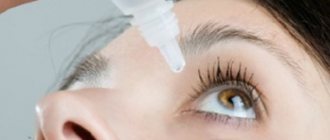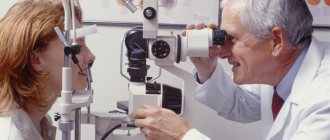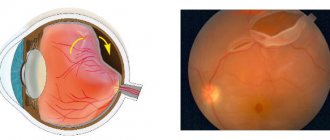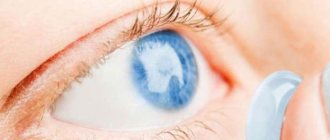Vision for license category B (BE, B1)
The simplest restrictions apply for drivers of passenger cars:
12. Visual acuity is below 0.6 in the best eye and below 0.2 in the worst eye with tolerable correction with 2 eyes open, regardless of the type of correction (spectacles, contact, surgical), the degree and type of ametropia or eye length.
Let's figure out how to use this point in practice:
- Have your visual acuity measured by an ophthalmologist. You will receive 2 numbers (one for each eye).
- Choose the larger one of the two numbers. If it is equal to or greater than 0.6, then everything is in order, a certificate will be issued. You don't have to watch the next steps.
- If the visual acuity of the “better” eye is 0.5 or less, then move on to the second number. If the second digit is 0.2 or more, then a certificate will be issued.
- If the visual acuity of the “worst” eye is 0.1 or less, then a certificate will not be issued.
Let's look at a few examples to better understand in what cases a certificate will be issued.
Left eye 1.0; right eye 1.0. The visual acuity of the better eye is 1.0, it is more than 0.6, that is, a certificate will be issued.
Left eye 0.8; right eye 0.5. The visual acuity of the better eye is 0.8, it is more than 0.6, that is, a certificate will be issued.
Left eye 0.6; the right eye is missing. The visual acuity of the better eye is 0.6, it is equal to 0.6, that is, a certificate will be issued. For category B, the absence of one eye is not a reason for not issuing a certificate.
Left eye 0.2; right eye 0.5. The visual acuity of the worse eye is 0.2, it is equal to 0.2, that is, a certificate will be issued.
Left eye 0.2; right eye 0.2. The visual acuity of the worse eye is 0.2, it is equal to 0.2, that is, a certificate will be issued.
Left eye 0.1; right eye 0.5. Visual acuity of the better eye is 0.5, it is less than 0.6. The visual acuity of the worse eye is 0.1, it is less than 0.2, that is, a certificate will not be issued.
Thus, a driver whose vision is (0.5; 0.1) or worse will not be able to obtain a medical certificate.
If at least one eye has a visual acuity of 0.6 or better, or two eyes have a visual acuity of 0.2 or better, then the certificate will be issued without any problems.
What restrictions exist on the issuance of rights?
To drive a vehicle, it is not enough just to learn the traffic rules and pass the theoretical and practical parts of driving. There are a number of contraindications in which a driver’s license is prohibited from being issued to a specific person. These may be persons suffering from mental disorders, cardiovascular pathologies, and diseases of the nervous system.
Also, young people under 18 years of age or, conversely, people who are too old cannot obtain a license. Various ophthalmological pathologies serve as obstacles: severe myopia or hypermetropia, glaucoma, achromatopsia - complete color blindness, some types of color blindness and other disorders associated with visual acuity and color perception. Its quality is strictly checked by a medical commission.
Color blindness is a disorder of color vision when a person cannot distinguish one or more colors. There are three main types of this pathology: difficulties in distinguishing between red, blue-green and yellow-green shades. For verification, special Rabkin polychromatic tables are used. They are made up of 27 pictures in which colored circles form shapes or numbers.
Separate requirements are also imposed on those who are forced to constantly wear contact lenses or glasses. The difference between the optical power on the left and right eyes should not be more than 3 diopters. If on one of them the vision function is completely absent, then even in this case a person can drive a car, but the permissible acuity on the seeing eye in this case must be at least 0.8 units. At the same time, sufficient horizons (field of vision) must be ensured.
Here are the sharpness parameters for those who use optics on a regular basis:
- drivers of special (category B), as well as passenger transport - visual acuity of the healthy eye is at least 0.8 and visual acuity of the weak eye is 0.4;
- category C - for both eyes more than 0.7 or for healthy eyes at least 0.8 and for visually impaired - 0.4 or more;
- category B - for healthy or both eyes more than 0.6 and for visually impaired - more than 0.2 units.
In short, visual acuity can be different - it affects the specific driving category that you want to obtain. The doctor will take this into account.
Vision for driving license categories A, M (A1, B1)
The requirements for two-wheelers are similar to those for cars, but there are important differences:
1. Visual acuity is below 0.6 in the best eye and below 0.2 in the worst eye with tolerable correction with 2 eyes open, regardless of the type of correction (spectacles, contact, surgical), the degree and type of ametropia or eye length.
2. Blindness of one eye with visual acuity below 0.8 with tolerable correction in the sighted eye, regardless of the type of correction (spectacles, contact, surgical), degree and type of ametropia or eye length.
The main difference is that special requirements apply to a driver who is missing one eye. Such a driver must have a visual acuity of 0.8 or more in his only eye.
A certificate for category A can be obtained in the following cases:
- 0.6 or more - in the better eye, if both eyes see.
- 0.2 or more - in each of the two eyes.
- 0.8 or more if there is only one eye.
Also, for category A and M licenses, the use of corrective devices (glasses, lenses) is allowed.
Why is astigmatism dangerous for a driver?
The ocular anomaly is characterized by a number of signs that make driving, without exaggeration, dangerous:
- blurred contours of objects in motion, regardless of their distance;
- inability to correctly determine the distance to oncoming cars, buildings, people;
- distortion of the contours of objects on the road and sidelines;
- pain and rapid eye fatigue from strain while driving, accompanied by headaches;
- a gradual decrease in visual acuity not felt by the driver.
These arguments are quite enough to visit an ophthalmologist and reduce the risk when obtaining a driver's license.
Vision for categories C, D (Tm, Tb, CE, DE, C1, D1, C1E, D1E)
For drivers of freight and passenger transport, the vision requirements are the most severe:
21. Visual acuity is below 0.8 in the better eye and below 0.4 in the worse eye with tolerable correction with 2 eyes open, no more than 8 diopters over the superequivalent in the better seeing eye, regardless of the type of ametropia or type of correction (spectacles, contact).
22. Blindness of one eye, regardless of the visual acuity of the sighted eye.
Paragraph 22 states that in the absence of one eye, rights of categories C and D cannot be obtained. That is, the first condition for obtaining a certificate is both eyes.
It turns out that licenses for freight and passenger transport can be obtained with visual acuity:
- 0.8 or more in the better eye (if there are two eyes);
- 0.4 or more in each of the two eyes.
Let's look at a few examples:
Left eye 1.0; right eye 1.0. The visual acuity of the better eye is 1.0, it is more than 0.8, that is, a certificate will be issued.
Left eye 0.8; right eye 0.5. The visual acuity of the better eye is 0.8, it is equal to 0.8, that is, a certificate will be issued.
Left eye 1; the right eye is missing. If an eye is missing, a certificate will not be issued.
Left eye 0.4; right eye 0.5. The visual acuity of the worse eye is 0.4, it is equal to 0.4, that is, a certificate will be issued.
Left eye 0.4; right eye 0.4. The visual acuity of the worse eye is 0.4, it is equal to 0.4, that is, a certificate will be issued.
Left eye 0.3; right eye 0.7. Visual acuity of the better eye is 0.7, it is less than 0.8. The visual acuity of the worse eye is 0.3, it is less than 0.4, that is, a certificate will not be issued.
Attention! When checking vision for driving freight and passenger transport, glasses or lenses can also be used, but the correction should be no more than 8 diopters on the better-seeing eye.
What is the definition of sufficient vision when driving?
The right to drive a vehicle is granted if the state of the visual system meets the following requirements:
- consideration of signs at a certain distance sufficient to make a decision on a maneuver, including the speed of response in non-standard situations;
- having a good eye for moving in traffic at complex road junctions;
- seamless visual response simultaneously to instrument readings and information on road signs;
- horizon of more than 20 degrees;
- the ability to maintain dimensions and conduct quality parking.
- distinguish colors and have high stereoscopic vision regardless of the time of day (especially at night);
- do not suffer from serious eye diseases (glaucoma, etc.).
Attention! Driving with astigmatism at night is not recommended.
How to prepare for a medical vision examination?
The human body is designed in such a way that visual acuity depends, among other things, on eye fatigue. Therefore, if you are planning to receive a certificate to replace your license, it makes sense to prepare for this and give your eyes a break . You can use the following tips:
- See your eye doctor early in the day. Your eyes rest while you sleep, so you need to get a good night's sleep.
- Don't overstrain your eyes in the previous days, stop watching TV and reduce the time spent on a computer or mobile device.
- Ideally, go for a medical examination immediately after vacation, when your eyes have had enough time to rest and relax in a few days.
A driver receives a medical certificate only once every 10 years, so it makes sense to prepare a little for the commission and give your eyes a rest.
In conclusion, I would like to note that refusal to issue a certificate for a passenger car due to poor vision is a rather rare situation. And even if this happens, don't be upset. Just go through the medical examination again with glasses.
To obtain a driver's license, you undergo an ophthalmologist examination.
An examination is required if visual acuity is poor; there are certain standards established by law. This is necessary to prevent the number of accidents.
According to the law, it is possible to obtain a license with one eye, but the requirements for a single functioning eye are becoming more stringent. However, the driver only has a license for personal use of the vehicle.
Using a car to earn money (working as a driver, taxi driver) is prohibited.
What kind of vision is it impossible to drive and get a license?
If during the next inspection it turns out that the driver does not meet the vision requirements, then you should use a vision correction device (glasses or lenses). In this case, the driver undergoes a vision test wearing glasses or lenses.
However, it should be borne in mind that if you undergo a medical examination wearing glasses or lenses, then you will subsequently have to drive a car only with glasses or lenses. In this case, a special GCL mark will appear in the rights.
Note. If the license has a GCL mark, and the driver drives the car without glasses or lenses, then he may be fined for lack of driving privileges - 5,000 - 15,000 rubles.
Thus, the GCL mark makes life a little more difficult for the driver. Therefore, if your vision is approximately on the border of acceptable values, then first try to pass the test without glasses. If this does not work, then take out the glasses and go through the test again.
Good afternoon, dear reader.
In 2021, to obtain or replace a driver's license, you must undergo a medical examination and obtain a medical certificate.
The medical commission includes several doctors, the list of which depends on the category of driver's license. However, for any category you will have to see an ophthalmologist (ophthalmologist). This is a doctor who checks the driver's vision.
And it is a check with an ophthalmologist that causes fear in many drivers, because... Over time, people's vision does not get better.
- This article will discuss the requirements for drivers’ vision:
- I would like to note right away that all the requirements for driver health are given in the following regulatory document:
List of medical restrictions on driving a vehicle
If you wish, you can study this document yourself. Below we will talk exclusively about limitations related to vision.
Vision requirements for the remaining eye
It is possible to drive a car if you are blind in one eye if the car is equipped with an acoustic parking system. These changes came into force in 2015 and are spelled out in the relevant resolution of the Russian Federation.
There are other requirements. Persons with the absence of one organ or complete blindness are allowed to drive a car for their own purposes, if visual acuity is not lower than 0.8 without correction. In this case, the seeing organ must be healthy.
If you have cataracts, glaucoma, impaired color vision or diseases of the lacrimal sacs on the only functioning organ, a license will not be issued.
Re-examination is carried out one year after receiving the driver's license.
After laser vision correction
Today, many people correct myopia or farsightedness in a radical way - with the help of laser correction. And although this method is considered relatively gentle, the procedure is performed in a matter of minutes and does not even require hospitalization of the patient, however, after laser correction, drivers must temporarily give up driving and sit in the passenger seat.
This is due to several reasons. On the one hand, during the rehabilitation period the eyes should not be overloaded, as this can lead to complications. On the other hand, in the first days after laser correction, the clarity of vision may be reduced, which for the driver means an increased risk of accidents. Therefore, you should not risk your health; you should refrain from driving for at least a week.
Passing a medical examination to obtain a driver's license
The examination is non-standard. The medical commission is required to check a person’s vision. They take place at a driving school, if it provides such services, or at a local clinic. A certificate can be obtained from a private ophthalmologist. The document must have the doctor's signature and the hospital/doctor's stamp.
When examined by an ophthalmologist, they undergo a thorough examination, which includes:
These are mandatory tests. If necessary, the diagnosis is supplemented by other studies. The test is carried out with glasses or contact lenses, it depends on what correction device the patient uses.
A medical certificate is issued when a person goes through more than just an ophthalmologist. It will record the results from the surgeon, otolaryngologist, neurologist, psychiatrist, narcologist and therapist. You receive it within 1–2 days.
After diagnosis
In diagnosing vision problems, eye doctors often use a method called ophthalmoscopy. This procedure allows you to carefully examine the fundus of the eye using an ophthalmoscope and assess the condition of the retina, in particular its macular zone, which is responsible for central vision. Also, ophthalmoscopy helps to identify pathologies of the optic nerve, eye vessels, opacities in the eye lens or vitreous body. In order to carefully examine all parts of the eyeball from the inside, the ophthalmologist must first dilate the patient’s pupil. This is usually done with the help of special mydriatic eye drops. They are instilled into the eyes 15 minutes before the procedure, after which the examination is carried out directly.
After using mydriatics, the pupil will return to normal and begin to function normally again in about two to three hours. Until this time, the patient’s vision may be blurry, and the sharpness may be noticeably reduced. After an ophthalmoscopy or any other medical procedure that requires pupil dilation, you should not drive for several hours, and you must wear sunglasses when going outside.











